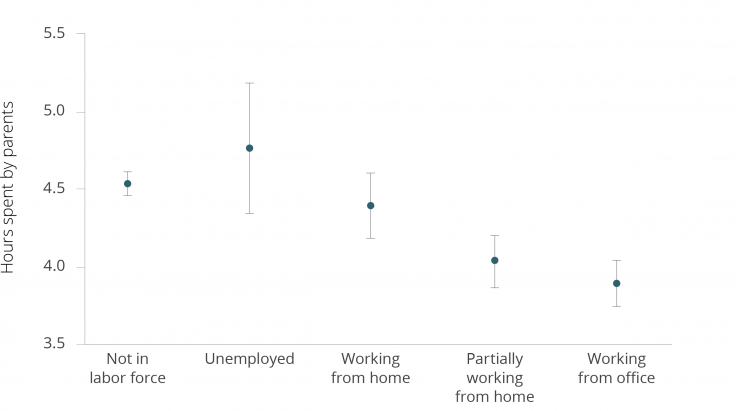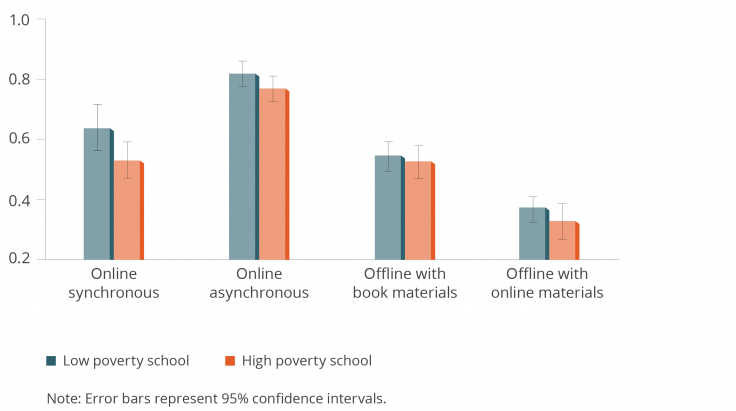Learning from Home During the Pandemic: The Experiences of Parents and Teachers

Project Summary
Location: Jakarta, Indonesia
Sample: 114 schools (sample size of 34,103 parents and 1,677 teachers). The online surveys were completed by 16,453 parents and 1,162 teachers.
Timeline: July–September 2020
J-PAL Initiatives providing funding: N/A
Target group: Primary schools, teachers, and parents
Outcome of interest: Student learning
COVID-19 dimensions: Education and learning
Mode of data collection: Online and phone survey
Nature of activities: Survey
Research paper(s): COVID-19 Widening the Gap in Education: Evidence from Urban Jakarta
Project Details
J-PAL Southeast Asia, in collaboration with the Jakarta’s Provincial Government and the DKI Jakarta Provincial Education Department, conducted an exploratory study to examine the implementation of home learning in Jakarta during COVID-19. This study explores the challenges and experiences of parents and teachers, specifically at the elementary school level. At this level, the ability of parents and teachers to support effective learning is crucial as it equips children for subsequent levels of learning.
Online surveys were conducted to teachers and parents in 114 sample schools between July 27 and August 4, 2020. A total of 16,453 out of approximately 34,000 parents (48 percent) in the sample schools completed the online survey. About 1,162 from approximately 1,667 teachers (69 percent) completed the survey. Qualitative phone interviews were also conducted between August 6 and 28, 2020 to provide more detailed insights on learning challenges and best practices by parents and teachers to overcome these challenges. Researchers successfully interviewed 198 parents, 50 teachers, and 10 school supervisors.
The survey finds that asynchronous online learning is the primary method used by teachers to deliver learning materials during home learning. From the perspective of parents, the biggest challenge in conducting home learning is maintaining children’s focus.
Research Results
The study includes samples from high-poverty and low-poverty schools, with the status determined by calculating the proportion of students receiving the Jakarta Smart Card (Kartu Jakarta Pintar - KJP) in each school. Schools with a proportion of KJP recipients above 50 percent were categorized as high-poverty schools, while schools with a proportion of KJP recipients below 50 percent were categorized as low-poverty schools.
Getting children to focus on learning material is the main challenge that parents in both high-poverty and low-poverty schools experience during Learning from Home (LfH). Preliminary notes from the phone interviews suggest that this challenge could be a result of children's boredom due to the lack of interaction with peers as well as the load of assignments that is perceived to be too high. Furthermore, the ability of parents to explain learning materials could also be a contributing factor. This particular challenge is more commonly experienced by parents with children in Grades 1 to 4 compared to parents with children in Grades 5 and 6. Referring to findings from the phone interviews, one of the innovative strategies that parents do to help their children focus is by allowing their children to engage in enjoyable activities such as drawing and painting.
Parents with children in Grades 4–6 tend to spend higher average hours accompanying children to study. One possible explanation is that children in higher grades receive a higher assignment load compared to those in the lower grades (Grade 1–3).
There is an indication that the burden to accompany children during home learning is bigger among mothers. This is indicated by the lower average hours spent by parents in accompanying their children if the mother is working, either fully or partially, from home or at the office (see Figure 1). If a mother is not in the labor force or is unemployed, the average hours spent to accompany children is more than 4.5 hours in a typical school day, while for mothers who work partially at home and work fully from home the average hours are 4.4 hours and 4 hours, respectively. Mothers who work full time in the office spent less than 4 hours accompanying their children. On the other hand, the father's employment status (either from home, from office, or partially working) is not correlated with the average hours spent by parents accompanying their children.

Teachers in high-poverty schools and low-poverty schools use asynchronous online learning as the primary teaching method. Teachers have the option to deliver learning materials using online synchronous methods through video meeting applications (Zoom and Google Meet). However, the limited mobile internet quota and additional technical skills required from both parents and teachers to use those supporting applications are the main challenges that limit the implementation of such a method.

From Figure 2, we can also see that the percentage of teachers using synchronous online learning is higher among low-poverty schools, highlighting possible inequality in access and capacities of teachers and parents in implementing home learning. As a way to adapt to students' limited internet and smartphone access, several teachers conducted limited online learning at school or visited student homes to deliver materials and assignments. Additionally, adapting to the absence of the usual whiteboard and markers, teachers innovate by combining various methods of explanation. For example, in explaining about addition in Math, the teacher sends a verbal explanation via WhatsApp voice notes complemented with a short video sourced from YouTube. In another scenario, the teacher first uses materials in the school textbook, and if students still have difficulty understanding, the teacher will record and send a short explanation video. If this method still does not work, the teacher will send follow up voice messages.
Acknowledgment
The researchers would like to acknowledge Ma'rifatul Amalia, Chaerudin Kodir, and Terry Muthahhari from the J-PAL Southeast Asia office for their substantial contribution to this study.